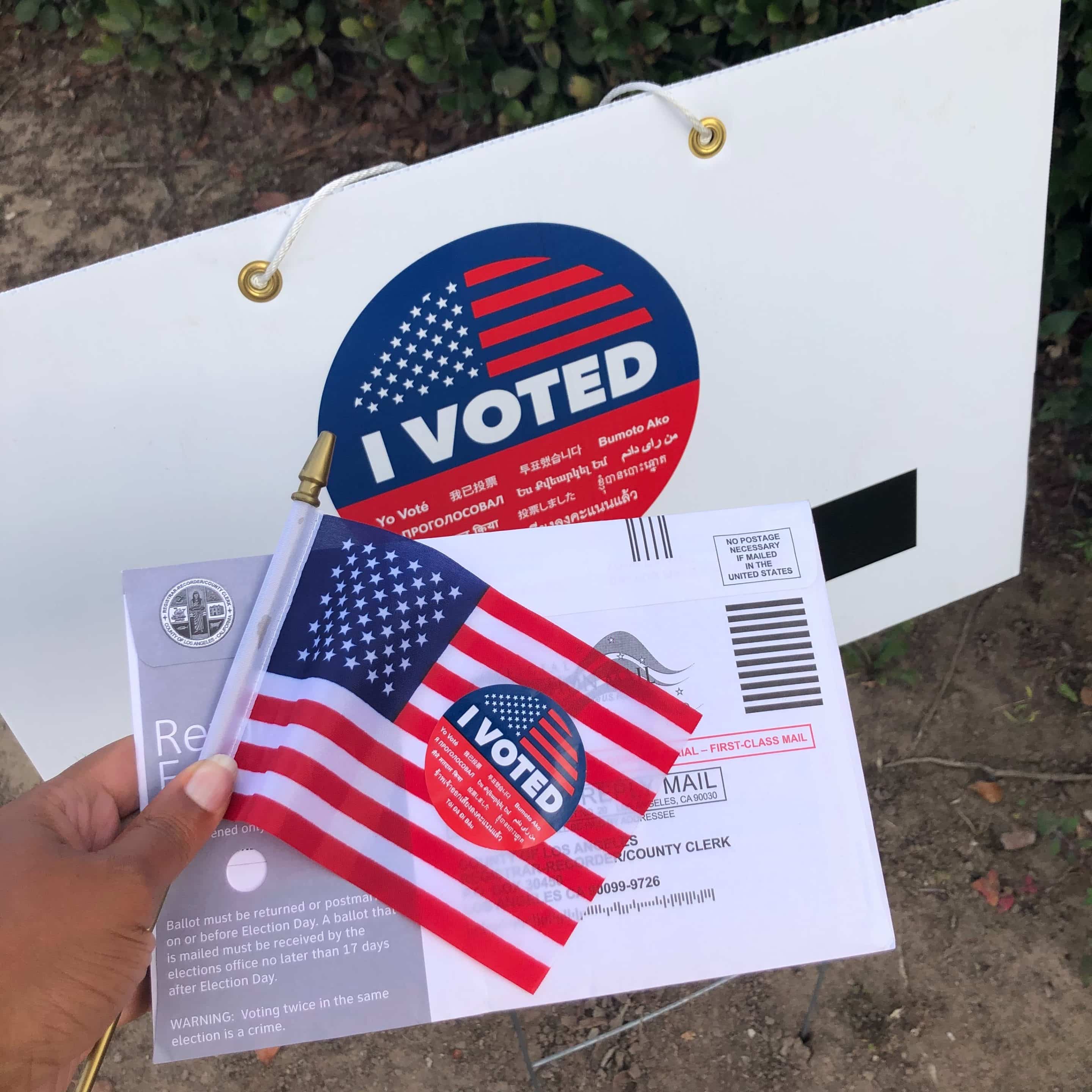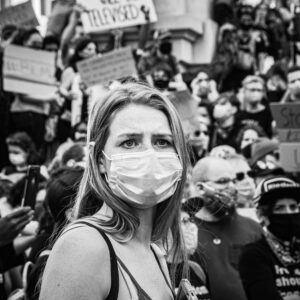Article shared by the Democracy Day project, written by Marta Campabadal for Stacker
As the 2022 midterm elections approach, voter turnout is becoming a topic of interest—notably because midterm elections have historically had much lower turnout than presidential elections. Despite this fact, the most recent midterm election, held in 2018, saw a higher percentage of voters hitting the polls than during any midterm since at least 1978. Voter interest in this year’s elections is expected to be just as significant, if not more so, because issues such as abortion rights and inflation have atomized the American public from across the political spectrum. Stacker asked a series of experts the deceptively simple question, “Why should people vote?” and received varied, albeit complementary, views.
Jasleen Singh, counsel for the Brennan Center for Justice’s Democracy Program, said, “Voting is a fundamental right in a democracy, and only when the right to vote can function at its fullest does democracy work well.”
Samantha Kelty, who works to eliminate voting obstacles faced by Native Americans as a staff attorney for the Native American Rights Fund, agreed. “Participatory democracy is how we create justice and positive change for everybody without a voice,” she said.
Christopher Beem, managing director of the McCourtney Institute for Democracy and associate research professor of political science at Penn State University, sees a large-scale social shift in how Americans view both their role in a democratic society and the impact of that democracy on their lives. “In the last few years, we have come to understand that democracy is hard work, that it requires a lot from all of us, and that it’s fragile,” Beem told Stacker. “I think that we are in a point in our history where we all need to do what we can to preserve democracy.” Beem went on to say that the well-being of democracy starts with voting, but it doesn’t stop there.
Singh echoed Beem’s sentiment to some degree, saying that, in looking back at how political events unfolded in 2020 as well as what has transpired since then, “lawmakers’ [claims of] ‘stolen’ elections and election irregularities have been used to justify laws that restrict voting rights.” In Singh’s opinion, this issue is the result of an increasing divide in the U.S., which is manifesting in it becoming easier to vote in places where it was previously relatively easy to vote, and much more difficult where difficulty was already the norm.
Programs and Outreach Director for the League of Women Voters Maggie Bush indicated that the importance of voting goes beyond simple allegiance to a political party or ideology: “Americans are worried about the economy, the safety of kids in school, reproductive rights, and the future of climate, and voting is the way to have some power over these issues.”
Aside from whatever political or social issue captures or creates the zeitgeist in a given time period, are there keystone characteristics behind why people vote? Are there core human traits that are ever present or underlying motivations that goad people to action? And what are the external factors that bear the greatest and deepest influence? In short, what makes people vote?
Stacker is participating in Democracy Day, a national call to action that highlights the importance of our democracy and the struggles we currently face in protecting it. As part of our coverage of this important topic, we’ve interviewed the aforementioned experts and compiled data from multiple sources—including FiveThirtyEight’s Voting Laws Tracker and an analysis by the American Psychological Association—to create a list of the top motivations behind people’s participation in the electoral process.
Altruism
In his book “Altruism and Self-Interest in Democracies: Individual Participation in Government,” Richard Jankowski, in analyzing the psychological motives by which people vote, cites altruism—or having a concern for the wellbeing of other people—as the primary factor in choosing to vote. While Jankowski cites Downs’ 1957 theory that self-interest was the lone impetus behind a person’s choosing to cast a ballot, he unpacks it further, saying someone voting to support people and causes that they care about “so that those people and causes may be more successful” is actually the stronger motivation. In other words, the motivation is altruism.
A June 2020 poll conducted by the Center for Information & Research on Civic Learning and Engagement found that 83% of young people believe their participation in the electoral process has the power to “change the country” and that 60% feel they are actively part of a movement that “will vote to express its views.”
Selfish interest
Not all voters are deliberately looking out for others in choosing whether to vote or not. An October 2020 study led by members of Michigan State University faculty and the Michigan State Bar found that the polar opposite was true: While there is evidence to uphold Jankowski’s belief in the influence of altruism, it also found selfishness to be a strong motivator.
The study found that voting to increase income or reduce expenses, or “because there is a potential economic benefit, such as reducing taxes or increasing government benefits,” are common justifications that those voting on the basis of self-interest use for heading to the polls—or choosing not to. It refers to the power dynamic between altruistic and self-interested motivation for voting as the “paradox of voting.”
Personal duty
As part of a society, we all engage in what is sometimes called the social contract, and within that concept, each person bears their own personal duties. Taking care of family members, holding down a job and being responsible for it, submitting projects on time as a student or employee, paying taxes, respecting one’s community—the social norms are endless. Voting, for many, is also seen as a personal duty, even an extension of the social contract. As the Michigan State study points out, one of the reasons people vote is for personal duty, which means voting because “it is the right thing to do,” and a person feels better when they vote and have upheld that duty.
Belonging
According to the Michigan State study, a sense of belonging is one of the most important factors for people to vote, the idea being that voting makes you feel like you are “participating in something larger” and that you are “part of a community.”
A plethora of organizations and platforms in the U.S. are devoted to helping average voters mobilize their communities and reinforce the intrinsic value of voting to support one’s community. Some of the most widely known include the Rock the Vote campaign; When We All Vote; Help America Vote Day, sponsored by the U.S. Election Assistance Commission; and the National Alliance on Mental Illness, which outlines ways and means on its website for people to engage in their communities and find issues they can support.
Social approval
The human need to gain approval from friends, family, and co-workers is a powerful motivator. Some families have been Republicans or Democrats for generations; often, friend and peer groups can have a political foundation of shared ideas and opinions. As stated in the Michigan State study, when we go to the polls for social approval, “we seek external validation when we act in ways to earn the ‘goodwill’ and approval of significant others.”
Having a stable context
This aspect is strongly linked to the voting motivation of finding a sense of belonging. Duke University social psychologist Wendy Wood, who is also co-director of the Social Science Research Institute, conducted a study alongside political scientists John Aldrich and Jacob Montgomery, in which she concluded that aside from election-specific voters, or those who are strictly motivated by a single candidate or issue, having a stable context is key. Such voters Wood called “habitual voters,” the ones who have a track record of showing up every time. These voters usually live at the same address through multiple elections and are able to maintain consistency through many actions in their lives, including voting.
This does not mean that habitual voters necessarily always vote for the same party, regardless of candidate or election cycle. As Wood said, “You could show up habitually, but vote in a thoughtful way.”
Voting laws
Samantha Kelty, of the Native American Rights Fund, told Stacker that historical discrimination remains a strong influencer when it comes to voting in America. “There is a specifically targeted assault on voting rights that affects specific voters,” Kelty said. “For example, strict voter ID laws and elimination of registration are especially harmful to communities of color.”
According to the American Civil Liberties Union, 11% of U.S. citizens—some 21 million people—lack a government-issued photo ID card. The ACLU further points out that 25% of Black citizens of voting age lack an acceptable form of ID; 8% of white citizens lack sufficient identification.
Research conducted by FiveThirtyEight, which shows voting restrictions by state, confirms that voter turnout can be impacted by voter registration and ID laws, as well as early voting and polling place accessibility. FiveThirtyEight pointed out that since 2020, 24 states have passed 56 laws to restrict voting—the greatest number of both since 2011, which saw 14 states pass 19 laws among them.
The Brennan Center’s Jasleen Singh told Stacker that “laws should ensure access to various methods of voting, [provide] voting hours that are long enough to accommodate different people, and be thoughtful about voting methods.” Unfortunately, that doesn’t always happen. Kelty warned that the most harmful voting laws are related to the denial of a vote due to any number of specious circumstances, including lack of pre-registration, minor edits or discrepancies in a person’s signature, provisional barriers to registration such as voting laws that have been changed or augmented since the last election, and disruptions at voting sites.
Sept. 12-16 is Disability Voting Rights Week. According to the U.S. Census Bureau, 41.1 million people—or 12.7% of the total civilian population—live with some type of disability in the U.S.; they’re also among the most negatively affected by unfair voting laws. For example, the elimination of voting by mail in Texas made it exponentially more difficult for people with mobility challenges to cast their votes.
But not everything is negative. “Forty states have online registration,” Maggie Bush of the League of Women Voters said. “In 20 states you can register on the same day of the elections, almost 20 states have automatic voter registration, and none of those things were as widely utilized 10 years ago.”
Demographics
Although voter turnout in the U.S. tends to be lower compared to other democracies—despite the right to vote being one of the hallmarks of U.S. citizenship—the percentage of the voting-age population that cast ballots in the 2018 midterm elections was the highest it had been in 40 years, according to the U.S. Census Bureau. Even though voter turnout improved in every age group that year, only about 36% of voters between 18-29 years old—the youngest age group by the Census’ classification—voted. Voters aged 65 and over had the highest turnout of all age groups at 66%.
In terms of race or ethnicity, voter turnout varied from a high of 58% among white voters to a low of 40% among both Hispanic and Asian voters. Women turned out at a slightly higher rate than men in 2018—even though, as Bush pointed out, “women are still not represented in terms of candidates at nearly close numbers, and they are disproportionately impacted by barriers, especially young women who don’t go to college and immigrants.”
Finally, socioeconomic status has also proven relevant: In the 2018 midterm elections, just over 30% of voters in households earning less than $20,000 per year cast a ballot compared to about 60% turnout among voters with household incomes between $75,000 and $100,000. Although the political landscape in 2022 is quite different than it was in 2018, early polls indicate that turnout may be similar.
How can we encourage people to vote?
One big question remains: how can we get more people to the ballot box? Singh thinks it’s useful to “talk to your friends, family, and neighbors, and make sure they know why participating in our democracy is so important.” She also suggests that people make sure they are registered, that they have filled in their mail-in ballot forms, that their IDs are updated on their registration, and that they consult trusted sources like their state’s or county’s official voter registration websites.
To address the inequity still interfering with Native Americans’ ability to vote, the Native American Rights Fund backs the Native American Voting Rights Act. Kelty explained that were the act to be ratified, “things like tribal IDs would be accepted, and polling places would have to provide oral language assistance,” among other safeguards.
Beem was unequivocal: “What I would say to young people, members of ethnic groups, and those with a specific identity is that they are trying to take you out of the electorate and take out your voice, restrict your power. And the only way that you can do anything about that is by getting out and voting.”
Finally, as if to put to rout any question of interpersonal responsibility, Bush said, “The most important thing is to register and to make a voting plan, and be aware of how voting works in your state, so if you’ve moved, you have it under control.”






